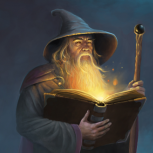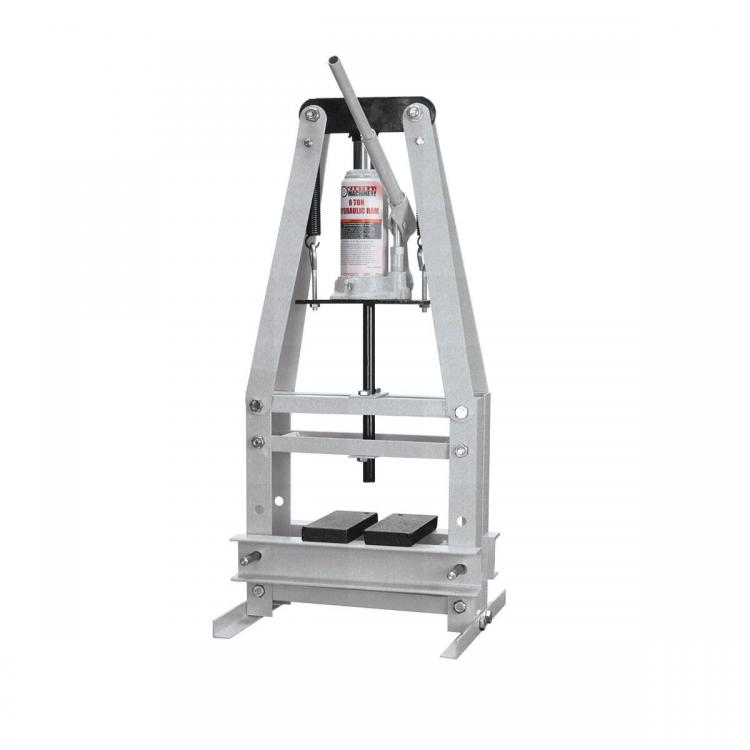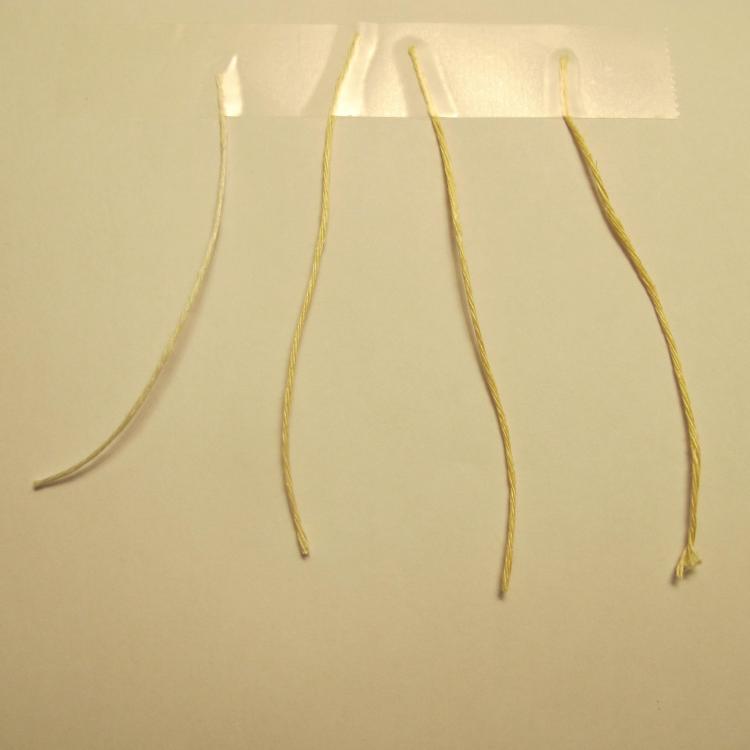-
Posts
562 -
Joined
-
Last visited
Content Type
Profiles
Forums
Events
Blogs
Gallery
Everything posted by wizard of tragacanth
-
Frodo, you are not weird at all... you are imaginative and creative. That is a nice effect and I think that it fits your style, quite well, actually. nick
-
The Harbor Freight Arbor Press is rated at 1-ton and may work with a cheater-bar. The A-frame shop press definitely has the power but I just don't know how you would modulate the pressure. With no feedback, you can't know when to stop. It would work for cutting dies of course. For stamping, maybe you could rig up a dial gauge that would tell you when the press has been moved half a millimeter? I don't know. I like Matt's solution of the heated press, however, it sounds pricey. The Tandy version is $500 but I'm sure there are cheaper ones out there. nick
-
Many of us own a version of that one, obtained from Harbor Freight. I use it for my 1" maker's mark. Don't know how well it would work for a 3" stamp. It may work but you would have to make sure that your leather is well cased and you would have to really lean into the press with all of your weight... I'm guessing. You may need to go with something more beastly, like a 6-ton shop press. The problem with the shop press is that you have no feel for how hard you are stamping. The shop press is only about $20 more than the arbor press. HF has frequent sales, so if you are not in a hurry, keep an eye out. Oh, and If you are on their email or snail-mail mailing list, I think that every month they will give you a coupon for 20% off of any one item. https://www.harborfreight.com/6-ton-a-frame-bench-shop-press-1666.html nick
-
I like it! Years ago, a guy on this forum, made a holster with sort of a "granite" looking texture to it. I really liked it. He had pressed the leather into a sidewalk IIRC. Tried it myself, but I couldn't get the same look. Didn't have the right type of sidewalk, I guess. One time, I embossed some leather using a piece of canvas, to give it the look of fabric. My technique wasn't perfect but it worked to some degree. I will be trying this technique again. nick
-

Free spill stand for Fiebings 440ml dye
wizard of tragacanth replied to chrisash's topic in 3D Printers and Lasers
That is a fantastic idea and absolutely wonderful that you are sharing it! Wish I had a printer -

Sig 938 Holster
wizard of tragacanth replied to AA3JW's topic in Gun Holsters, Rifle Slings and Knife Sheathes
Well, it was a good effort. Consider that to be prototype 1. Please take my constructive comments in the gentle manner in which they are intended. The gun is sitting too high in the holster. The stitch line in front of the trigger guard needs to be lowered, at least to the point that the leading edge of the trigger is below the top of the holster. You don't want to get a shirt tail or something caught between the trigger and the holster. There is plenty of depth left on that holster. It is difficult to know how much because these guns are small, but I would say there is at least 1/2" - 1" of extra depth there. Use it. However, do not drop the gun so low that you cannot get a full firing grip on it while it is in the holster! Also, there is no sight channel. The holster has been molded too close to the slide, behind the front sight. I use a small dowel or chop-stick, flattened on one side and taped to the slide, running from the rear of the front sight to the rear sight. This maintains an open path for the sight, when drawing the pistol. Otherwise, you may find yourself, scraping leather out of the holster with every draw. As you mentioned, this leather is a little too thick for this project. Since this is a small gun, maybe try 7/8 oz leather next time. Can't wait to see your next one. nick -
For measuring, I often use a transparent orange, plastic 12" ruler, and for cutting, I use a cork-backed 12" stainless steel ruler. I have a 48" stainless steel ruler, to cut the long straight edge that I need for a strap cutter. I don't need a square because I don't make anything square, in leather. Maybe some day though, I will make a wallet. nick
- 13 replies
-
- mini square
- square
-
(and 2 more)
Tagged with:
-
Around 40 years ago, I dyed a white cotton T-shirt, using Black Tea, and called it my Tea-Shirt. It was a private joke. Still is. nick
-
I guessing that this is in Los Angeles, California, based on the Palm trees and that the book was published by the Autry Museum of Western Heritage, in Los Angeles. I cannot remember when color photography really came around for the general public but I am thinking it was in the early 1960's. Based on that, I am guessing that the photo could have been taken in the 1950's. However, some people still used B&W film after the advent of color. So, who knows? Puzzling, however, is that I could not find a reference to the "Autry Museum of Western Heritage" having ever existed. The "Gene Autry Western Heritage Museum" was founded in November of 1988. Perhaps the OP can cite the publishing date for the book but it is of no consequence because the photo could have been taken before or after the book was published. Today, the Roar Parade is a motorcycle gathering. nick
-

Adam savages portable leather tool box
wizard of tragacanth replied to Treesner's topic in Leather Tools
Thanks Treesner. To me, the most interesting aspect was that he built the box as a box, then sliced it to make the doors... perfect fit, every time. Also, the vertical "chemistry set" design was a very good idea. The work area is not crowded with tools. nick -
Okay, Fred... maybe on your side of the Pond. It seems like every time that I pick up my ruler, I have the wrong side up. If I need inches, its millimeters or vice versa. Ha! I once had a girlfriend from Oxford. I asked her what was the best thing about living in the US? Her answer was -- flow-through tea bags! That was nearly 30 years ago. Maybe you have them over there now! nick
-

Beeswax for holster finish
wizard of tragacanth replied to bcraig's topic in Gun Holsters, Rifle Slings and Knife Sheathes
You might want to try Sno Seal. It is "emulsified" (can't think of a better word) bee's wax... ready to use. It's pretty soft in the jar. Warm the leather, apply it and repeat if necessary. Personally, I do not want to make my holsters softer. I want to make them firmer. nick -
All of my measuring tools have both inches and millimeters -- rulers, yard sticks and steel tapes. I didn't know that you could buy one that didn't. nick
-
Oh, and another thing. Retention. These are my personal thoughts about that... How much retention do you need? Myself? Not that much. I carry every time I leave the house. I am what I would consider a "average citizen" CCW holder. For me, sufficient retention is if I can jump up and down without the gun falling out. However, that is not enough for someone who has a very good chance of getting in a fight or a wrestling match. That kind of retention should not be left to the molding of the ejection port and trigger guard. If that kind of retention is needed, then a "retention device" is necessary, such as a strap. Personally, I do not need a strap, nor do I want one because I do not want to deal with one in the event that I needed to draw immediately. bcraig -- BTW: "can't" is a contraction for "can not". The term that you want is "cant". nick
-
There is no such thing as a flat back pancake holster. A pancake holster is a 50/50 holster. The pattern for the front and back are simple mirror images of the exact same dimensions. Molding is done on both sides, again, like mirror images. A flat back holster, has a flat back, or a gently curved back that follows the contours of the waist. All of the molding is done on the front (outside) panel. Flat back holsters are much more comfortable. The belt can be drawn tight to pull it in close, like a saddle on a horse. This does not create any discomfort. A pancake holster has a hard bulge on the back, that when drawn tight, will bear into your body, like putting a baseball under a saddle on a horse. Do you want a baseball under your saddle? nick
-

Nambu Holster
wizard of tragacanth replied to JayB's topic in Gun Holsters, Rifle Slings and Knife Sheathes
Just thinking. If you do try the method that I suggested, for authenticity, you might want to make the color less uniform... splotchy. You could do a very quick dip to give an overall tone, then add extra color to only parts of the thread. Make a small coil by wrapping it around three fingers, then lay that coil down and dribble some more coffee in a couple of areas. When you uncoil it... ta-da! -

Nambu Holster
wizard of tragacanth replied to JayB's topic in Gun Holsters, Rifle Slings and Knife Sheathes
Well, IDK if it is worth your time and gas to go there. The 25 yard spool of thread is only $5.50. Maybe it would be better to just order it online. Also, if you go there, it could end up costing you hundreds or thousands of dollars. No kidding. You might start buying tools and supplies for years to come. If you do go there, get some bee's wax and some stitching needles. I can't remember which ones I use. I thought it was the #2 Glover's Needles but I don't see that on the website. It's either those or the harness needles. Do not buy the "Stitching Needles" with the BIG eye. nick -

Nambu Holster
wizard of tragacanth replied to JayB's topic in Gun Holsters, Rifle Slings and Knife Sheathes
Okay, I was shootin’ from the hip, with that recommendation, so I tried it myself. I used Black Coffee. Here are the results. Four samples are shown, on a background of – HP Ultra White, Multi-Purpose Paper. Left to Right: Natural, 3 second dip, 30 second dip, 5-10 minutes. The bluish pic was taken outdoors in the shade, the yellowish pic was taken indoors under a Warm White LED bulb. nick -

Nambu Holster
wizard of tragacanth replied to JayB's topic in Gun Holsters, Rifle Slings and Knife Sheathes
Hopefully someone will come along here and give you the REAL answer to this, but this would be my approach. I have not yet tried what I am recommending but this is what I would do. I would start with an un-waxed natural linen thread, such as this Tandy product. https://www.tandyleather.com/en/product/unwaxed-linen-thread-natural If the color of the thread is too white, I would make a cup of black tea or maybe coffee and start experimenting. The tea or coffee will be used to dye the thread. Dip short 6" pieces of thread in the tea, let it dry completely and then wipe the thread by drawing it through a paper towel. That may remove some color. Experiment with length of time for the dipping until you get the desired color. After you get the timing right, dye the thread that you need for the project. Then, lightly wax the thread by placing it on a chunk of wax, putting your thumb on top of it and drawing the thread over the wax a time or two. If I have time this afternoon, I will try this and let you know what happens. nick -
Well, you go to the Springfield Leather Company website and you search for Single Shoulder (Craftsman) and you find out it is $25. Here's the direct link. https://www.springfieldleather.com/Import-Single-Shoulder-Craftsman Now that is not premium leather but it should be good enough for a beginner. The label of "Craftsman" grades is a common term for the lower grades that are offered, but the cost is low and they are perfect for practice. The "extra" leather that you get with the single shoulder will probably come in handy. Everyone makes mistakes and must re-cut pieces. Then, you may also want to use some of it to practice making holes, dying, edging, etc. before you make your project. Choose the weight of the leather that is appropriate for your project. A small holster may be okay in 6 oz. a medium holster in 8 oz and a larger one in 10. As JLS said, if you use 2 layers, then they would total that amount, like 2x5 oz = 10 oz. This is just a general guideline. I have made a couple of holsters in 6 oz., just because I had it on hand, and I was not happy with them. BTW, Those were for me. I am a hobbyist and rarely sell my stuff. However, I do give some to relatives as gifts. If you get a single shoulder, you will have enough to make a gift or two, as well! BTW, if you have a Tandy Leather Store near you, I highly recommend that you go there and look at the leather in person. The first time I went, I didn't even know what veg tan was. It was a bewildering experience. Didn't have any idea what to look for. I told the woman who worked there that I wanted to make holsters. She was not much help, I wound up with 12 Saddle Skirting. Would have been great if I was making shoe soles! I am not suggesting that poor customer service is the norm there. You may find what you want there. Since leather is not a uniform thickness, it is usually listed with two weights, such as 8/9 or 9/10. Look for a shoulder with as few blemishes as possible. Look for as little fuzz on the back as possible. A shaggy back is not good. You want it to be as uniform as possible, front and back. They won't be perfect but that is the goal. nick
-
I finally got around to looking at that link for the leather. SLC is a good company but you are looking at the wrong item. When you buy these pre-cut project pieces, they are good, flawless leather but the cost is high. These are more appropriate for making journals, notebooks or such... that is, square projects that will use all or most of the leather. You would waste a lot of that leather making an irregular shape like a holster. What you should probably be looking at is a single-shoulder. Cost per square foot is lower. The shape is irregular but this should be enough leather to make a couple of holsters out of. Personally, I started with single-shoulders, and I think many of us do. Then I graduated to double-shoulders, then half a cow, I mean Sides. Later, I started buying Bends. Really nice stuff. BTW, the "hair side" is also known as the "Grain", so you don't get confused if you hear this down the road. nick
-
You only want to make one or two holsters? Yeah, sure... this is how the madness starts. You can't see it, but we can! Watch this YouTube video with Sam Andrews, to learn how to do it. https://www.youtube.com/watch?v=5PdKDmcmu8k Can't tell you if the eBay leather is appropriate unless you provide a link. nick




